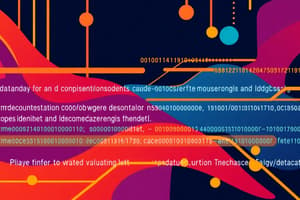Podcast
Questions and Answers
Which of the following best describes a database?
Which of the following best describes a database?
- An accumulation of raw data without any structure or format.
- A collection of unrelated data stored for archival purposes.
- An organized collection of logically related data designed to meet information needs. (correct)
- A temporary storage space for unprocessed data.
Which example is NOT typically associated with a database application?
Which example is NOT typically associated with a database application?
- Purchases using a credit card
- Studying at university
- Booking a holiday at the travel agents
- Sitting in traffic (correct)
What is metadata in the context of a database?
What is metadata in the context of a database?
- Data that is irrelevant to the database structure.
- Data processed to create knowledge from user data.
- Data that describes the properties and context of user data. (correct)
- Data related to the storage capacity of the database.
What kind of data does a database primarily store?
What kind of data does a database primarily store?
What term is used to describe data processed to increase knowledge?
What term is used to describe data processed to increase knowledge?
What is the primary purpose of graphical displays in data management?
What is the primary purpose of graphical displays in data management?
Which of the following describes a file processing system?
Which of the following describes a file processing system?
What is a disadvantage of file processing systems?
What is a disadvantage of file processing systems?
What is meant by 'data context'?
What is meant by 'data context'?
Which statement reflects program and data interdependence?
Which statement reflects program and data interdependence?
The corporate database serves which primary function?
The corporate database serves which primary function?
What was a significant historical development in the use of computers?
What was a significant historical development in the use of computers?
Which of the following is NOT a characteristic of data description?
Which of the following is NOT a characteristic of data description?
What is a primary disadvantage of file processing related to development?
What is a primary disadvantage of file processing related to development?
Which issue arises from data redundancy?
Which issue arises from data redundancy?
What is a key feature of a Database Management System (DBMS)?
What is a key feature of a Database Management System (DBMS)?
How does the database approach improve data integrity?
How does the database approach improve data integrity?
What problem does limited data sharing typically cause?
What problem does limited data sharing typically cause?
What does excessive program maintenance primarily consume in an information systems budget?
What does excessive program maintenance primarily consume in an information systems budget?
What is one consequence of programs being written in different languages?
What is one consequence of programs being written in different languages?
What is a significant advantage of using a centralized database?
What is a significant advantage of using a centralized database?
Flashcards
Database
Database
A collection of logically related data, designed to meet the information needs of an organization.
Data
Data
Stored representations of meaningful objects and events. It's the raw material of information.
Metadata
Metadata
Data that describes the properties and context of user data. It helps understand the data itself.
Information
Information
Signup and view all the flashcards
Program-data independence
Program-data independence
Signup and view all the flashcards
Data Visualization
Data Visualization
Signup and view all the flashcards
Data Description
Data Description
Signup and view all the flashcards
Corporate Database
Corporate Database
Signup and view all the flashcards
File Processing System
File Processing System
Signup and view all the flashcards
Data Redundancy
Data Redundancy
Signup and view all the flashcards
Data Inconsistency
Data Inconsistency
Signup and view all the flashcards
Data Redundancy (Duplication)
Data Redundancy (Duplication)
Signup and view all the flashcards
Limited Data Sharing
Limited Data Sharing
Signup and view all the flashcards
Lengthy Development Times
Lengthy Development Times
Signup and view all the flashcards
Excessive Program Maintenance
Excessive Program Maintenance
Signup and view all the flashcards
Vulnerable to Inconsistency
Vulnerable to Inconsistency
Signup and view all the flashcards
Database Management System (DBMS)
Database Management System (DBMS)
Signup and view all the flashcards
Database application program
Database application program
Signup and view all the flashcards
Study Notes
Database Systems - Chapter 1
- Databases are organized collections of logically related data.
- Databases are shared collections of data designed to meet the needs of multiple users in an organization.
- Databases are self-describing collections of integrated records.
- Databases model real-world systems in a data format.
- Examples of database applications include supermarket purchases, credit card purchases, booking holidays, library use, insurance, video rentals, internet use, and university study.
- Data are stored representations of meaningful objects and events.
- Data can be recorded and stored on computer media.
- Data can be structured (e.g., numbers, text, dates) or unstructured (e.g., images, videos, documents).
- Information is processed data that increases knowledge.
- Metadata describes the properties and context of user data.
- A database is a shared collection of logically related data (and a description of this data), designed to meet the information needs of an organization.
- A system catalog (metadata) describes the data to enable program-data independence.
- Logically related data comprises entities, attributes, and relationships.
- Context aids understanding of data (e.g., class roster example).
- Graphical displays turn data into useful information for decision-making and interpretation.
- Metadata describes data properties, types, field sizes, allowable values, and context. (e.g., Table 1-1 example).
- A shared organizational database serves various departments (e.g., Management, Marketing, Sales, Product Development, Manufacturing).
- Computers were initially used for computational/engineering purposes.
- Commercial applications later introduced file processing systems.
- File processing systems comprise multiple application programs that define and manage their own data.
- Database systems provide data sharing and data independence.
- Database systems offer controlled redundancy and better data integrity.
- A Database Management System (DBMS) is software that creates, maintains, and controls access to databases.
- Database application programs interact with DBMS via appropriate requests (SQL statements).
- DBMS manages data resources like operating systems manage hardware.
- Advantages of the database approach include program-data independence, minimal data redundancy, improved data consistency, improved data sharing, increased application development productivity, enforcement of standards, improved data quality, improved accessibility and responsiveness, reduced program maintenance, and improved decision support.
- Disadvantages of file processing include program-data dependence, data duplication, limited data sharing, lengthy development times, excessive maintenance, and vulnerability to inconsistency.
- Problems with data redundancy include wasted space and potential for different values and formats for the same data.
Studying That Suits You
Use AI to generate personalized quizzes and flashcards to suit your learning preferences.




